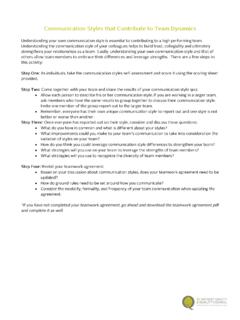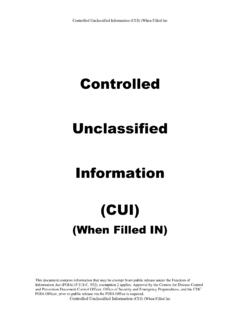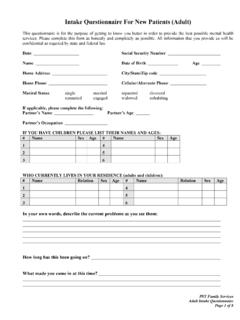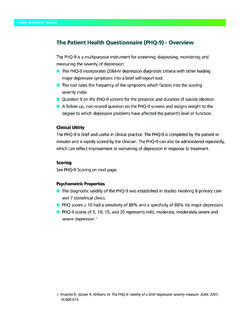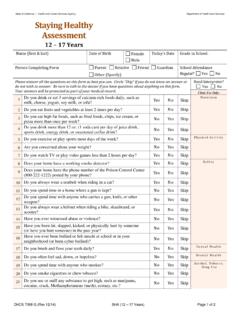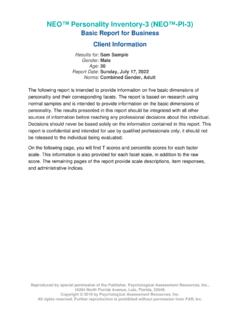Transcription of Team Assessment Questionnaire - BC Patient Safety ...
1 Team Assessment Questionnaire (Lencioni, P. (2002). The five dysfunctions of a team. San Francisco: Jossey-Bass.) Instructions: Use the scale below to indicate how each statement applies to your team. It is important to evaluate the statements honestly and without over-thinking your answers. 3= Usually 2= Sometimes 1= Rarely 1. Teams are passionate and unguarded in their discussion of issues. 2. Team members call out one another s deficiencies or unproductive behaviors. 3. Team members know what their peers are working on and how they contribute to the collective good of the team. 4. Team members quickly and genuinely apologize to one another when they say or do something inappropriate or possibly damaging to the team. 5. Team members willingly make sacrifices (such as budget, turf, head count) in their departments or areas of expertise for the good of the team.
2 6. Team members openly admit their weaknesses and mistakes. 7. Team meetings are compelling, not boring. 8. Team members leave meetings confident that their peers are completely committed to the decisions that were agreed on, even if they were in initial disagreement. 9. Morale is significantly affected by the failure to achieve team goals. 10. During team meetings, the most important and difficult issues are put on the table to be resolved. 11. Team members are deeply concerned about the prospect of letting down their peers. 12. Team members know about one another s personal lives and are comfortable discussing them. 13. Team members end discussions with clear and specific resolutions and action plans. 14. Team members challenge one another about their plans and approaches. 15. Team members are slow to seek credit for their own contributions, but quick to point out those of others.
3 Scoring Combine your scores for the preceding statements as indicated below: Dysfunction 1: Absence of Trust Statement 4: _____ Statement 6: _____ Statement 12: ____ Total: _____ Dysfunction 2: Fear of Conflict Statement 1: _____ Statement 7: _____ Statement 10: ____ Total: _____ Dysfunction 3: Lack of Commitment Statement 3: _____ Statement 8: _____ Statement 13: ____ Total: _____ Dysfunction 4: Avoidance of Accountability Statement 2: _____ Statement 11: _____ Statement 14: ____ Total: _____ Dysfunction 5: Inattention to Results Statement 5: _____ Statement 9: _____ Statement 15: ____ Total: _____ A score of 8 or 9 is a probable indication that the dysfunction is not a problem for your team. A score of 6 or 7 indicates that the dysfunction could be a problem. A score of 3 to 5 is probably an indication that the dysfunction needs to be addressed.
4 Regardless of your scores, it is important to keep in mind that every team needs constant work, because without it, even the best ones deviate toward dysfunction. Members of a team with an absence of Team that fear A team that fails to A team that avoids A team that is not focused on Conceal their weaknesses and mistakes from one another Hesitate to ask for help or provide constructive feedback Hesitate to offer help outside their own areas of responsibility Jump to conclusions about the intentions and aptitudes of others without attempting to clarify them Fail to recognize and tap into one another s skills and experiences Waster time and energy managing their behaviours for effect Hold grudges Dread meetings and find reasons to avoid spending time together Have boring meetings Create environments where back-channel politics and personal attacks thrive Ignore controversial topics that are critical to team success Fail to tap into all the opinions and
5 Perspectives of team members Creates ambiguity among the team about direction and priorities Watches windows of opportunity close due to excessive analysis and unnecessary delay Breeds lack of confidence and fear of failure Revisits discussions and decisions again and again Encourages second-guessing among team members Creates resentment among team members who have different standards of performance Encourages mediocrity Misses deadlines and key deliverables Stagnates/fails to grow Rarely defeats competitors Loses achievement-oriented employees Encourages team members to focus on their own careers and individual goals
